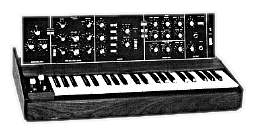 When the album "Electronic Realizations for Rock Orchestra"
was originally released in mid-1975, an avalanche of mail
landed at the Passport Records company offices. Many of the
letters asked similar questions about the LP. The
mimeographed answer sheets that were mailed out in response
provide a terrific time capsule from 1975. It shows the
state of recording technique and commercially available
synthesizer equipment at the time. It also gives a little
insight into what I was planning at the beginning of my
recording career. What follows are the answers to some of
those early frequently asked questions.
When the album "Electronic Realizations for Rock Orchestra"
was originally released in mid-1975, an avalanche of mail
landed at the Passport Records company offices. Many of the
letters asked similar questions about the LP. The
mimeographed answer sheets that were mailed out in response
provide a terrific time capsule from 1975. It shows the
state of recording technique and commercially available
synthesizer equipment at the time. It also gives a little
insight into what I was planning at the beginning of my
recording career. What follows are the answers to some of
those early frequently asked questions.
Remember, at this time (1974-75) there
were no personal computers as we know them. Apple Computer
didn't exist yet; Microsoft was two hackers selling tiny
BASIC code for other experimenters. Synthesizers were mostly
analog and usually restricted to playing one note at a time
(no chords). MIDI was years away. And digital recording was
still pretty much a development lab project, though a few
early classical recordings were being made on specialized
equipment.
FREQUENTLY
ASKED QUESTIONS
WHAT IS
SYNERGY:
HOW
WAS THE ALBUM RECORDED:
ANSWERS
TO THE MOST-ASKED QUESTIONS ABOUT THE EQUIPMENT
USED:
WHAT
IS THE BACK COVER, HOW WAS IT DONE:
THESE ARE ANSWERS TO THE
MOST-ASKED QUESTIONS FROM 1975 AS THEY WERE ANSWERED IN
1975-1976:
WHAT
IS SYNERGY:
SYNERGY is technically a property or
reaction where the sum exceeds the properties of the
component parts. A metal alloy that is stronger and more
durable than any of its component parts is an example of
SYNERGY. So are many chemical reactions. And so would a
recording of a limited number of discrete sonic elements
done on a 16 or 24 track recorder that ends up sounding like
a 150 piece orchestra. That is why I adapted Buckminster
Fuller's central physical-ecological theme to my
music.
SYNERGY as a musical unit is intended
to be somewhat free-form and expandable. Right now it is
based purely in electronic music, but it can easily cross
over into multi-media work, more conventional rock and
classical forms, and eventually, I expect into electronic
technical developments. Though I am the main member of
SYNERGY, it might include others in the future, as projects
warrant.
return
to top of FAQs
HOW
WAS THE ALBUM RECORDED:
From July through December 1974, I
recorded 4-track demo versions of all the material on a TEAC
3340 recorder. These started as small sections which were
revised and expanded into the original pieces that appeared
on the album. During the latter part of September, in a fit
of frustration, I recorded the entire length of "Slaughter
On Tenth Avenue", one of my old favorites, just so that I
could have a complete piece of electronic work under my
belt. Producer Marty Scott liked the piece so much that we
decided to use it on the LP. Following the demo version of
"Slaughter", the other pieces began to fall into place.
Though most of the original material on the album is new,
some of it dates back 2 or 3 years to college music course
projects, and some of my old group's music.
During December (1974), I recorded
timing and reference tracks at home to be dubbed onto the 2
inch 16 track master. All track recording was done at House
Of Music Studios in West Orange, NJ. I did all recording on
my own synthesizer equipment set up next to the control room
board so that I could act as engineer and tape-op. The
recording was done using Ampex 406 2" tape on an MCI 16
track machine connected to an MCI 18 in/16 out board. dbx
noise reduction was used. All instrument lines were, of
course, direct. Recording was fairly unaltered except for
some UREI compression on the Mellotron. Altec monitor
speakers powered by Phase Linear amplification were also
used.
Since it became imperative that a
computer mix be done, it also became necessary to do a tape
transfer to convert the dbx noise reduction over to Dolby A.
This was done at Bearsville Sound in Bearsville, NY using 2
Ampex MM-1000 16 track recorders with the appropriate noise
reduction devices. The copy was onto Scotch 250 2"
tape.
Mixing was done at Media Sound in New
York. It was the first mix done on the API/Allison 32 input
computerized mixing board at Media. The playback machine was
an Ampex MM-1100 24/16 track. Mixdown was in quad with a
simultaneous QS encoded 2 track master (from which the LP
was cut) and 4 track 1/2" discrete version made for safety
purposes and Q8 cartridges. The mix was monitored on quad
sets of both Altec studio speakers and KLH home speakers.
The mix was onto Scully 2 and 4 track machines. Mastering
was done at Sterling Sound in New York by Robert Ludwig
using the 2 track QS, Dolby master mix.
return
to top of FAQs
ANSWERS
TO THE MOST-ASKED QUESTIONS ABOUT THE EQUIPMENT
USED:
Galvanic
Skin Response Voltage Controller: More questions have
been asked about this toy than all of the other instruments
put together. It is a custom device that I built which sends
a small current through the player's skin. Varying the
pressure of any skin surface on a pickup plate causes
variation in skin impedance causing a corresponding change
in the controller's voltage output. It is surprisingly easy
to control. When patched for VCO pitch control it gives
sweeping frequencies much like a ribbon
controller.
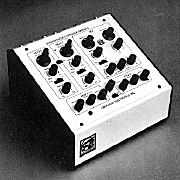 Oberheim Expander
Module: A nice little box made by Tom Oberheim in
California which has 2 VCOs, 2 Envelope Generators, 1 LFO, 1
multi-mode VCF and a VCA which can be wired into a standard
Mini-Moog or directly to Oberheim's sequencer. The Expander
Module was used mostly to get more sound out of the
Mini-Moog onto a single tape track rather than having to use
several multi-tracks of the Mini to get the same sound. The
Expander was a great help in organizing the most economical
use of the 16 tracks available.
Oberheim Expander
Module: A nice little box made by Tom Oberheim in
California which has 2 VCOs, 2 Envelope Generators, 1 LFO, 1
multi-mode VCF and a VCA which can be wired into a standard
Mini-Moog or directly to Oberheim's sequencer. The Expander
Module was used mostly to get more sound out of the
Mini-Moog onto a single tape track rather than having to use
several multi-tracks of the Mini to get the same sound. The
Expander was a great help in organizing the most economical
use of the 16 tracks available.
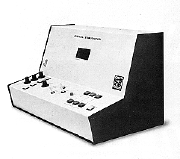 Oberheim
DS-2 Digital Sequencer: This is another magic box that
serves as a control voltage and timing memory using computer
memory techniques. When properly wired into the existing
Mini-Moog circuitry, the DS-2 will "remember" up to 72
events (notes, triggers, filter changes, etc.) on command
and play them back as needed. On playback the voltage
outputs can be varied to provide several octaves of
transposition, and the timing can be speeded up or slowed
down by a factor of several thousand times. This is one of
the most advanced pieces of synthesizer hardware on the
market today. It is also one of the first commercial pieces
of digital equipment which will most likely gradually
replace our current analog-based synthesizer designs over
the next 5 to 10 years.
Oberheim
DS-2 Digital Sequencer: This is another magic box that
serves as a control voltage and timing memory using computer
memory techniques. When properly wired into the existing
Mini-Moog circuitry, the DS-2 will "remember" up to 72
events (notes, triggers, filter changes, etc.) on command
and play them back as needed. On playback the voltage
outputs can be varied to provide several octaves of
transposition, and the timing can be speeded up or slowed
down by a factor of several thousand times. This is one of
the most advanced pieces of synthesizer hardware on the
market today. It is also one of the first commercial pieces
of digital equipment which will most likely gradually
replace our current analog-based synthesizer designs over
the next 5 to 10 years.
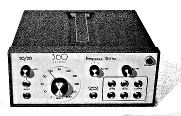 360
Systems 20/20 Frequency Shifter: ...another magic
device. This one has input and output jacks and a large
control knob. If a signal is applied to the input, the
control knob can be adjusted so that the output will appear
the same except shifted up or down in frequency by up to
5000 Hz. Great for turning a baritone into a soprano or a
set of bongos into timpani. On SYNERGY I used it mostly for
its built-in ring modulator circuit rather than its
frequency shift capabilities which are more suited to
working with conventional instruments.
360
Systems 20/20 Frequency Shifter: ...another magic
device. This one has input and output jacks and a large
control knob. If a signal is applied to the input, the
control knob can be adjusted so that the output will appear
the same except shifted up or down in frequency by up to
5000 Hz. Great for turning a baritone into a soprano or a
set of bongos into timpani. On SYNERGY I used it mostly for
its built-in ring modulator circuit rather than its
frequency shift capabilities which are more suited to
working with conventional instruments.
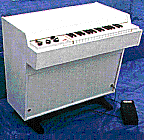 Mellotron: This is a
standard Mellotron 400D with the usual flute, strings and
cello tapes. The Mellotron actually only appeared on about 4
to 6% of the total tracking on the album since most of the
time synthesized strings and flutes are much cleaner and
crisper than the Mellotron's primitive tape playback
systems. All Mellotron sounds are controlled tape playbacks
of conventional instruments rather than totally electronic
sound generation as with a synthesizer.
Mellotron: This is a
standard Mellotron 400D with the usual flute, strings and
cello tapes. The Mellotron actually only appeared on about 4
to 6% of the total tracking on the album since most of the
time synthesized strings and flutes are much cleaner and
crisper than the Mellotron's primitive tape playback
systems. All Mellotron sounds are controlled tape playbacks
of conventional instruments rather than totally electronic
sound generation as with a synthesizer.
QS Quad:
After looking over the several quad systems available, QS
seemed to meet most of the requirements for releasing the
record in quad better than the other systems. For a start,
it is completely compatible. All copies of this SYNERGY
recording are in quad; there is no separate stereo release.
If you bought it at all, you bought it in quad. The QS quad
plays on a stereo turntable with no damage to the record,
and in mono with no problems if the mix was done right. QS
broadcasts on FM with all quad encoding intact. It costs no
more to press the records than stereo; and with Sansui's
Variomatrix quad decoders it gives up to 20 dB separation in
all directions. It also does a neat little trick with the
stereo image when played back in stereo by spreading the
stereo channels out wider due to the phase encoding used to
differentiate the four channels. (see diagram)
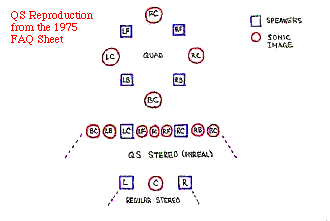
return
to top of FAQs
WHAT
IS THE BACK COVER, HOW WAS IT DONE:
The back cover is an infrared color
photo done without any filters of an old (ca. 1955) Brook
hi-fi power amplifier. The amplifier puts out a whopping 10
watts which was considered pretty powerful back then for a
home unit. For the photo, the tubes were all polished up and
the amplifier run in a dark room for an hour or so. A series
of photos were taken from different angles and with a
variety of exposures. The one finally used was taken with a
Nikon F camera with a standard 50 mm lens with a +1 diopter.
The exposure was about 55 minutes @ f.16 on Kodak Ektachrome
Infrared film.
return
to top of FAQs
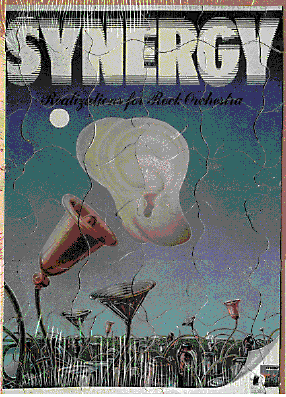 This is a jigsaw puzzle that was created from the poster for
"Electronic Realizations" that was sent out to record stores
in 1975. The album cover wasn't available since the artwork
was only licensed for use on the record itself, not for
posters. The hovering ear over the garden of electronic
components got a lot of attention and weirded out a few
people.
This is a jigsaw puzzle that was created from the poster for
"Electronic Realizations" that was sent out to record stores
in 1975. The album cover wasn't available since the artwork
was only licensed for use on the record itself, not for
posters. The hovering ear over the garden of electronic
components got a lot of attention and weirded out a few
people.
return
to top of FAQs
© 1997 Synergy®
Electronic Music, Inc.
This page was last updated on August
12, 1997
|